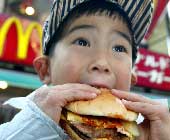 |
| A boy bites into a McDonald’s hamburger in Tokyo on Wednesday. The first US case of mad cow disease sent shares of McDonald’s Holdings (Japan) down by 3 per cent. The company said the US case would have no impact on its business in Japan — the world’s largest importer of American beef — as it gets all its beef from Australia. (Reuters) |
Washington, Dec. 24 (Reuters): Mad cow disease, which officials said had been found for the first time in the US, still mystifies scientists because it is not caused by a virus, bacteria or other microbes, does not alert the immune system and can jump from species to species.
US agriculture secretary Ann Veneman said the disease, formally known as bovine spongiform encephalopathy, or BSE, had been found in a single Holstein cow in Washington state on the US West Coast.
Humans can get a form of Creutzfeldt-Jakob disease known as vCJD from eating beef products infected by BSE. At least 137 people have died of vCJD, all linked to eating beef or to having received blood or tissue transplants from vCJD patients.
“In contrast to the traditional forms of CJD, vCJD has affected younger patients (average age 29 years, as opposed to 65 years for CJD), has a relatively longer duration of illness (median of 14 months as opposed to 4.5 months) and is strongly linked to exposure ... to BSE,” the World Health Organisation said in a statement.
BSE and CJD are members of a class of diseases called transmissible spongiform encephalopathies, or TSEs. They are believed to be caused by misfolded proteins called prions. TSEs affect cats, mink, elk, deer, cattle, sheep and a range of other animals. Rabbits, horses and dogs seem to be resistant but it is not clear why. TSEs can be passed on in food. Cattle are believed to have become infected with BSE when they were fed the rendered remains of sheep, which have their own TSE called scrapie.
Rendering or processing food can destroy the prions, but only with difficulty. Just cooking will not do the trick.
Experts were not available to comment on the case of the US cow last evening, but there is disagreement on just which beef products may carry the infectious prions that cause the disease. British officials say milk cannot transmit the agent, but there is strong evidence that nerve tissue and other cattle parts ground up for some products may carry it.
A recent Swiss study suggested that, in theory, muscle tissue — which would include steaks — could carry the agent. No one knows how much a person has to eat to become infected.
Because the misfolded proteins, or prions, believed to cause the TSEs occur naturally in the body, they do not alert the immune system as a virus or bacteria would to prompt a fight against the disease.
Recent research suggests the “bad” prions can cause others to go bad simply by touching them.
Proteins are made by cells following instructions laid out in the genes. But like a cardboard box, a protein must be folded to function and they sometimes get folded into the wrong shape. Usually a cell will recognise this and cause it to be broken up. But Susan Lindquist of the Whitehead Institute at the Massachusetts Institute of Technology and colleagues found in late 2002 that this does not always happen. They discovered that if the misfolded prions are not broken up quickly enough, they accumulate and alter the cell’s metabolism, killing it.
In the brain this kills neurons. When the neurons die they break apart, releasing more prions into the system. There is a genetic susceptibility to TSEs. For example, CJD occurs sporadically, or randomly, in about one in 1 million people. CJD is incurable and always fatal, can also be passed on by tissue transplants.











